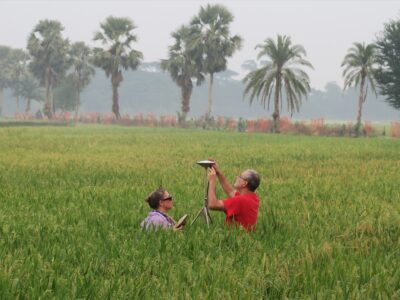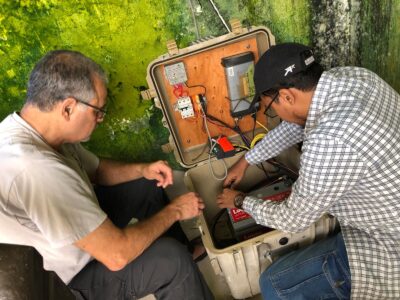
We arrived in Bangladesh this morning after a full day of traveling. I left home over 25 hours and 11 time zones ago. Our first field season is underway. It is exciting to be back. For my companions, it is their first time here. I will enjoy their seeing it for the first time. Bangladesh is an amazing landscape. Two of the world’s biggest rivers combine to create the world’s largest delta. This fertile land is home to 150 million people. Half the population of the US in a space a little larger than NY state. But in addition to the amazing, dynamic rivers, active tectonics are encroaching from the north and east. The Shillong Plateau, advancing in front of the mighty Himalaya, and the Burma Arc, the continuation of the zone that gave rise to the 2004 Sumatra-Andaman earthquake and tsunami, are both being thrust on top of the delta. We are here as part of a large NSF project to understand the interaction of the rivers and tectonics – and to decipher the record of each that is preserved in the delta sediments.
We are the second group. Nano Seeber and Ellie Ferguson arrived a few weeks ago to explore the geology of the Plateau and the Dauki Fault that bounds it. I am here with two Scotts, Scott Nooner from Lamont and Scott DeWolf from the University of California, San Diego. However, of or 18 pieces of luggage with the equipment, only 14 have arrived. The photo shows the Scotts discussing the missing luggage with the airline people. Turned out that other 4 are still in NY and won’t arrive until tomorrow. We hit the ground and immediately have to change plans. Instead of driving north today, we will stay in Dhaka and prepare here, buying odds and ends and getting equipment ready. In the morning we will go back to the airport and then straight to Jamalganj, about 7 hours away to the north.
Driving in during the early morning, Dhaka was a city asleep. Yesterday was National Language Day and Dhaka was waking up slowly from a day of celebration. Now shopping in the old city, we are trapped in a chaotic mix of cars, rickshaws, bicycle trucks, motorcycles. I look forward to getting out of the Dhaka traffic, getting our missing luggage and heading to the countryside.
When we ge to Jamalganj, we will be trying something new. We will attempt to directly measure the compaction of sediments in the delta; how they squish as new sediments are piled on top. The next 3 weeks will be a mixture of construction and precision technology, of PVC pipe and reinforced concrete on the one hand and fiber optic cables and geodetic grade GPS on the other. A team of drillers should be completing our first set of wells. Into these wells, we will install stretched fiber optic cable. Cementing them at the top and bottom. Each week, someone will electronically measure their length and we hope to watch as their length shortens over the years. A GPS will measure the subsidence of the surface.
This subsidence contributes to the record we will be studying. The land subsides and the rivers bring fresh sediment to fill it up. In the Mississippi Delta, all the damming of the rivers has dried up most of the sediment supply, and the delta is disappearing. Here, starting next month, we will be drilling hundreds of wells to recover the record of the rivers, the subsidence and the tectonics in a delta that is still growing.
Tomorrow we will drive across the this flat, dynamic landscape for 7 hours to where we will be working for the next 7-10 days.




Glad you all made it safe and sound. We hope all goes well.
We’re proud of all the great work you do.
This is fascinating—the project, the logistics, the environment. All very interesting.! The large population in an area the size of NY State is almost unfathomable.
Michael,
Sounds very interesting and exciting. Good luck with the trip and I look forward to reading future updates!
-Josh
I am so glad you created the blog. It will be really interesting to follow you day by day–hoping that you have good enough Internet access to blog frequently.